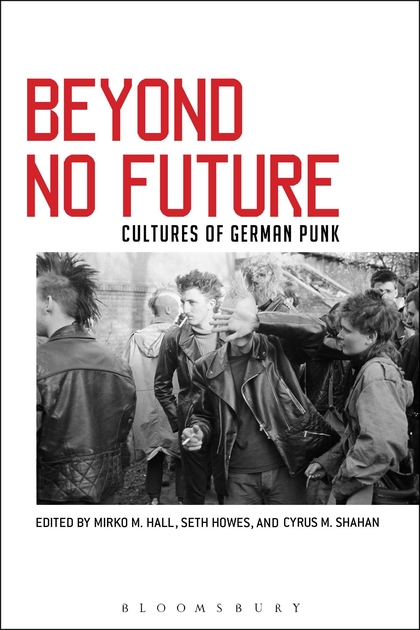
Beyond No Future: Cultures of German Punk edited by Cyrus M. Shahan, Seth Howes, and Mirko M. Hall

Beyond No Future: Cultures of German Punk offers an important contribution to the trend in punk studies to de-center punk from its Anglo-American origin story and examine the multi-directional influence of punk cultures across the globe. As the book’s title suggests, this anthology moves beyond a narrow reading of German punk as simply “chaos or style,” contained within a specific historical moment and summed up in the dystopian slogan: “no future.” Instead, the contributions to this anthology reveal how German punk operated (and continues to operate) on many different spatial and temporal registers and engaged with political and social problems on a national and transnational scale. This interdisciplinary anthology draws on diverse theoretical and methodological approaches from performance and sound studies, to cultural history and theoretical literature on boredom to expose an evolving set of political and aesthetic practices, world views, and world making in German punk and post-punk, from its first appearance in 1976 to the present. And what the eight substantive chapters in Beyond No Future implicitly reveal, the editors openly affirm in the anthology’s coda: “the dust has not entirely settled” on punk. Mirroring the brevity and directness of punk lyrics, the editors conclude: “Punk was not; it is” (169). Readers unfamiliar with German punk and post-punk are advised to keep an internet browser open to YouTube for quick access to visual and audio references to the songs and bands discussed in this anthology.
Despite its import from Britain and the United States, it was not long before Germans “made punk their own thing.” Soon after the first punk bands formed in West Germany in 1976, support structures like labels, clubs, and magazines also appeared to spread the visual and auditory experience to the growing circles of enthusiastic fans in the Federal Republic. Punk soon spread to the GDR, attracting the attention of the Ministry for State Security and a severe crackdown on the East German scene in 1983. Beyond No Future introduces readers to cultural aspects of the German punk phenomenon not typically found in the more straightforward histories of the genre. Though the contributors to this volume all come from German Studies backgrounds, their chapters represent a striking breadth of approaches to the topic, from punk spatiality, the interplay between aesthetics and politics in punk and post-punk cultural production, punk responses to German Vergangenheitsbewältigung (coming to terms with the past) and the subversive re-appropriation of the most provocative symbols of twentieth century Germany.
Part One focuses on the influences between German punk and space. Dennis Borghardt’s essay traces a shift in German punk cultures from the initial temporal perspective of “no future” to a spatial orientation after German unification. Borghardt examines how the banal features of the late capitalist urban landscape had a significant influence on punk lyricism within the three major punk hubs of the Federal Republic: Dusseldorf, Hamburg and Berlin. Noting the prominence of the ugly and the overlooked—the curb, the manhole cover, the building site— in the lyrics of bands like Nein Nein Nein, Kaput Krauts and Tocotronic, Borghardt argues that in the 1990s, punks developed a means of “world-writing” that combined individual emotions with the external ugliness and decay of late twentieth century urbanity. Moving us from the spatial back to the temporal register, Matthew Sikarskie highlights the influence of boredom on the formation of the early twentieth century do-it-yourself culture of the Wandervögel movement and German punk in the late 1970s. Sikarskie provocatively asks, “What might the history of subcultures in general (and German subcultures in particular) look like, if we wrote it as a history of boredom and its discontents” (50)? At the turn of the twentieth century, German youth in the Wandervogel movement began organizing group hikes and camping trips as an escape from the boredom and lack of personal fulfillment of modern capitalist society. The group spread into a broad network of Wandervögel groups across German-speaking Central Europe, with their own publications and folk song collections. Sikarsie notes a similar search for autonomous spaces arising from a dissatisfaction and rejection of modern life in German punk culture in the late 1970s. Both German punk and the Wandervögel also took advantage of modern technology, mass media, and the services of the state, while seeking autonomy from society through their do-it-yourself approach.
Part Two, “Performative politics,” features two disparate chapters on the politics of punk lyrics and Western-influenced scholarly discourse on punk in the GDR. Examining a range of lyrics from 1978 through 2012, Peter Brandes identifies the influence of German lyric poetry (and its political edge) on punk lyricism. Analyzing lyrics from the bands Toxoplasma, Slime, Canalterror, and EA80, Brandes reveals how these groups frequently used irony to re-contextualize literary references in response to contemporary concerns. Some of these literary references even came out of postwar German literature, like EA80’s allusion to the Heinrich Böll short story, “Murke’s Collected Silences.” Seth Howes highlights an example of transnational intertextuality in his examination of non-criminological accounts of the scene in East Germany. Howes reveals how GDR music scholars drew from the scholarship on punk coming out of Birmingham’s Centre for Contemporary Cultural Studies to form their own arguments on the nature of punk culture in the east. Howes focuses on a fascinating blind spot within East German punk criticism, stemming from the Western understanding of the punk subculture as a symptom of class struggle. If there was technically no class struggle in the GDR, this meant there could also be no subculture. But if GDR punk was not a subculture, asks Howes, “What was it, then” (86)? Howes proposes two possible routes to overcome this question: expand the definition of subculture within a socialist context, or abandon the term.
Part Three features four chapters examining punk responses to contemporary debates over the politics of history and the legacy of fascism in the late 1970s and early 1980s. Karen Fournier shifts the gaze from the Continent to Britain, and offers a much-needed explication of the complex of meanings behind the use of Nazi symbols within British punk. Fournier’s analysis highlights the deeper layers of meaning informing the punk swastika that were lost on outside viewers who solely viewed it as a symbol of racism. Through their embrace of the swastika and other allusions to German history, British punks exposed troubling parallels between Germany in the interwar and postwar period and the class struggle in Britain in the 1970s, prompting reflection on the disastrous outcome of class discontent in Weimar Germany.
Returning to the Federal Republic, Melanie Eis and Fabian Eckert examine the subculture’s ambivalent response to West Germans’ widespread emotional identification with Holocaust victims following the 1979 airing of the NBC Holocaust series in the Federal Republic. Through lyrics and sound, punk bands like Düsseldorf-based Der Plan and Mittagspause distanced themselves from both the emotional response and the universalizing tendency among the Left to connect the Holocaust to a human struggle against capitalism. Inspired by the historical avant-garde, punk bands instead embraced irony as a means of expressing a more ambivalent position toward Holocaust memory and focused instead on Nazi perpetrators. We see a similar critique of Germany’s postwar handling of fascism in Cyrus M. Shahan’s chapter on Hamburg-based post-punk band Deutsch-Amerikanische Freundschaft (DAF). But unlike the tactics of Der Plan and Mittagspause which focused their critique on the Nazi perpetrator, DAF paired a minimalist electronic sound alongside their elevation of sex and pleasure to “cut open the straightjacket of West German affect from within” (130). The band’s appropriation of fascist aesthetics and “misuse” of the German cultural tradition contributed to an overarching critique of postwar culture’s complicity in the West German avoidance of the past. Moving away from punk’s “no future,” DAF pursued an alternative use of culture in society that would open new relationships between the German past and present and a possibility for redemption.
In the section’s final chapter, Mirko M. Hall introduces readers to the French “cold wave” scene of the early 1980s and its preoccupation with Cold War Berlin. A variant of post-punk, the French “cold wave” used synthesizers and drum machines to create cold and synthetic music as a sonic reflection on the dystopian present. For the French “cold wave” bands, who largely originated outside major urban centers, no city better represented 20th century trauma and history—and aesthetic opposition—than Berlin. From a geographical distance in France, the cold-wavers latched onto Berlin as a symbol of contemporary dissatisfaction and melancholy and as a utopian site of “emancipatory potential for new forms of freedom.” As Hall notes, a recent surge of interest in the French “cold wave” reveals a renewed desire to “resurrect the critical-negative power of Berlin’s avant-garde substratum in the face of a neoliberal backlash” (160).
Beyond No Future does much to affirm the importance of the punk to 20th century German history and its rightful place within a longer narrative of avant-garde aesthetics and autonomous cultural production in modern Germany. The four chapters on punk and fascism in Part Three would all provide excellent stand-alone readings for introducing German punk into undergraduate courses on modern Germany and post-war German culture. This anthology offers little in the way of a general overview of the history of German punk, and regrettably limits the examination of the East German scene to a single chapter. Those seeking a history of German punk, in both East and West, would be wise to turn to Cyrus M. Shahan’s Punk Rock and German Crisis: Adaptation and Resistance after 1977, and to watch for forthcoming monographs from Seth Howes and Jeff Hayton.
Reviewed by Briana Smith, The University of Iowa
Beyond No Future: Cultures of German Punk
Edited by Cyrus M. Shahan, Seth Howes, and Mirko M. Hall
Publisher: Bloomsbury
Hardcover / 192 pages / 2016
ISBN: 9781501314087
Published on July 28, 2017.




